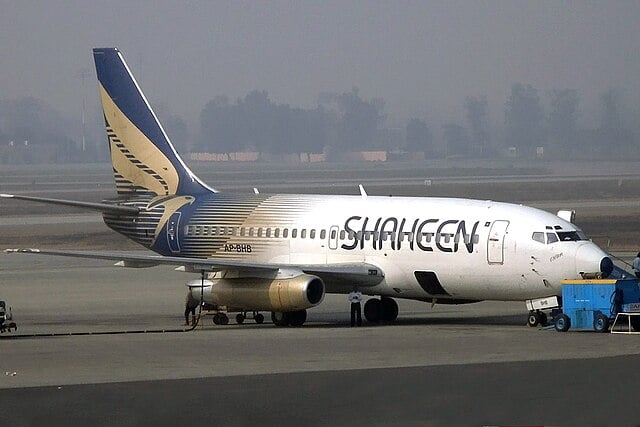Despite having such a large population, Pakistan has perennially lacked a strong domestic air travel network for various reasons. Nonetheless, the country’s aviation industry has recently grown immensely by adding new domestic airline companies. The total fleet size of airlines in Pakistan has increased to 57 planes as of 2024.
Global and Regional Context
Air travel is a significant business in today’s globalized world. The global civil aviation industry had a market share of around USD 842.71 billion in 2022. Out of the total global market, Asia Pacific accounts for the largest share, as growing economies in the region,, like India,, have emerged as leading countries in the civil aviation sector.
In Pakistan, the upward trajectory is also evident. As per the International Air Transport Association (IATA), Pakistan’s air traffic is projected to grow by 9.9% over the next 20 years compared to the base year of 2016.
Landscape of Active Airlines in Pakistan
Currently, five local airlines are operating in Pakistan. Excluding Pakistan International Airlines (PIA), four out of five airlines are private entities. The details are as follows:
Pakistan International Airline (PIA)
PIA is Pakistan’s national flag carrier, founded on 1 October 1953. It commenced its operations on 11 March 1955. Headquartered in Karachi, a merger with Orient Airways, which is the first private airline in Pakistan, created the new state-owned airline.

The Ministry of Aviation looks after PIA. Air Vice Marshal Chief Muhammad Amir Hayat is the current Chief Executive Officer of the airline.
The PIA had the largest market share, with 74% for domestic flights and 40% for international flights in 2022. The national carrier also possesses a modern and advanced aircraft fleet, including Boeing 777, Airbus A320, and ATR. The current fleet size of PIA stands at 32.
PIA has many achievements under its belt, including its crucial role in helping to start Emirates Airline and becoming the first Asian airline to operate a jet aircraft for commercial purposes. PIA is also the first non-Communist aircraft to fly into China.
Despite the feathers in its cap, PIA has now declined to a calamitous position. It is also undergoing a severe financial crisis due to mismanagement and maladministration. PIA’s financial losses have exacerbated the country’s economic problems. As per Miftah Ismail, former finance minister, the PIA had incurred losses of Rs 717 billion in 2023.
Owing to financial losses, privatization of PIA has been on the top agenda of successive governments. The Ministry of Privatization-Privatization Commission spearheads the privatization reforms.
In addition, it has had several crashes, including the most recent one in May 2020, primarily caused by human errors and violation of Standard Operating Procedures (SOPs).
Airblue Limited
Founded in 2003, Airblue commenced flight operations on 18 June 2004 with its head office in Islamabad. It offers several innovative and digitized services, including e-ticketing, self-check-in kiosk facilities, and wireless check-in for the first time in Pakistan.

Mr. Tariq Chaudhary is the CEO and chairman of Airblue’s board. The airline caters to the needs of various stakeholders and offers passenger and charter flights. It also provides cargo services within the country.
With a market share of around 30%, Airblue is the second-largest airline in Pakistan’s domestic aviation industry. It has a fleet size of 12 aircraft consisting of next-generation Airbus A320 and A321 neo-aircraft.
Airblue operates scheduled flights linking domestic destinations such as Islamabad, Lahore, Karachi, Peshawar, and Multan with international destinations of Dubai, Sharjah, Abu Dhabi, Jeddah, and Riyadh. It offers more than 70,000 kgs of cargo space on more than 18 flights daily.
In 2010, Air Blue Flight 202 from Karachi to Islamabad suffered a tragic accident that killed 156 passengers onboard.
Serene Air
In January 2017, Serene Air officially started its operation in Pakistan, with its headquarters in Islamabad. The current Chief Executive Officer of the Airline is Muhammad Safdar Khan.
In terms of market share and fleet size, Serene Air is the third-largest airline in Pakistan’s aviation industry. As of 2024, it had a fleet of seven aircraft. Serene Air makes bold promises with its Boeing 737s and Airbus A330s fleet. It has also been providing the best cargo services in Pakistan.
The airline operates domestic flights in six cities, including Lahore, Karachi, Quetta, Peshawar, and Islamabad. In 2021, it began operating international flights to the United Arab Emirates (UAE) and the Kingdom of Saudi Arabia (KSA1 after procuring approval from the Pakistan Civil Aviation Authority (PCCA).
Serene Air also launched its first flight to Beijing in November 2023, thus entering the international market.
Air Sial
Launched in 2015, it commenced its operation on December 25, 2020, for the route connecting Karachi and Islamabad. Air Sial is the brainchild of Sialkot’s business community, which is led by the Sialkot Chamber of Commerce and Industries (SCCI).
Following the leading private carriers, Airblue and Serene Air, Air Sial is ranked Pakistan’s third most prominent among all private airlines. Its headquarters is Sialkot International Airport Ltd. (SIAL). Fazal Jilani and Ameer Ahsan are the chairman and chief executive officer (CEO) of this airline.
Starting with three aircraft in its fleet, Air Sial has increased its fleet to 5 Airbus A320.
In addition to cargo and freight services, it operates passenger flights on domestic routes connecting Sialkot, Islamabad, Karachi, Lahore, and Peshawar.
Air Sial also launched its inaugural international flight to Jeddah in March 2023. It has gained approval to start flights to China, Malaysia, Sri Lanka, Thailand, Türkiye, the UK, and Kuwait in May 2024.
Fly Jinnah
Fly Jinnah is the youngest private airline, which commenced its operation on October 31, 2022, from Karachi to Islamabad. The airline takes pride in being the first low-cost airline in the country. It is a joint venture company of the Lakson Group in Pakistan and Air Arabia Group in the UAE.
It has a fleet size of 5 Airbus A230 aircraft flying on domestic and international routes.
The airline serves five major cities in Pakistan: Karachi, Lahore, Islamabad, Peshawar, and Quetta.
In addition, Fly Jinnah operates on several international routes, making inroads into the Middle East. These destinations include Muscat, Sharjah, and Bahrain.
Defunct Airlines in Pakistan
The aviation industry is an evolving sector in Pakistan. Airlines have a history of ceasing their operations due to financial insolvency and market failures. Two such cases are worth mentioning here to get some perspective.
Shaheen Air International
Shaheen Air International (SAI) is a case in point. The airline plunged into crisis in April 2018 when it defaulted on payments of taxes and fees to the Federal Board of Revenue (FBR) and Civil Aviation Authority (CAA) amounting to Rs3.1 billion.

Subsequently, it declared bankruptcy in 2018. SAI fell from grace from being the second-largest airline in Pakistan in terms of market share and fleet size.
Air Indus
Another case study is Air Indus, which began flying in 2013. However, the Civil Aviation Authority (CAA) revoked its license in 2015 because it did not meet the legal minimum requirements under Pakistani aviation laws. For example, it did not have a fleet of three airworthy aircraft.
Conclusion
In conclusion, Pakistan’s aviation industry is a small yet growing sector. Experts believe that the number of airlines is not commensurate with the country’s country’s large population. Currently, only five local airlines operate in the national sky, which has led to an uneven relationship between demand and supply. To meet this gap, new private airlines have successfully entered the aviation industry.
Critics have also raised questions regarding high fares, dubious credentials of professionals, and recurrent accidents by airlines. The expanding network of private airlines is a silver lining in the cloud amid the financial woes of the national carrier.
Lastly, dozens of airlines have come into existence, grounded, and vanished since independence, yet the local airline market has resisted outright failure, hinting at potential opportunities and entrepreneurial spirit.
If you want to submit your articles, research papers, and book reviews, please check the Submissions page.
The views and opinions expressed in this article/paper are the author’s own and do not necessarily reflect the editorial position of Paradigm Shift.
He writes on a diverse range of topics such as geopolitics, economy, social inequality, governance, and other important current affairs stories in national and international spheres.



